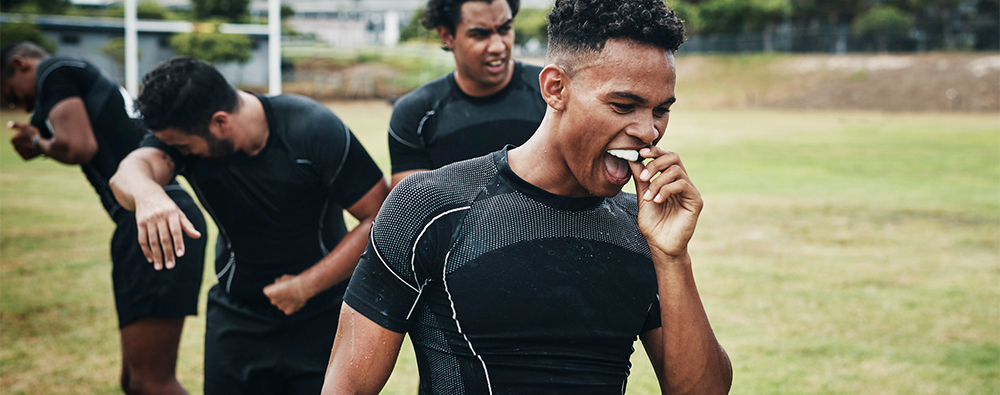August is Back to School month and we know that means your family is getting ready for a new academic year. If you have a child involved in athletics, you’re also focused on outfitting them with quality protective equipment – and that should always include a properly fitted mouthguard to protect their smile.
In a 2019 ADA analysis, mouthguard users were between 82% and 93% less likely to suffer dentofacial injuries than non-users. Mouthguards remain an essential part of protective equipment for youngsters and teens involved in contact and collision sports – including children who wear braces.
Schools typically require mouthguards for football, of course. However, the ADA recommends that children wear mouthguards for basketball, field and ice hockey, lacrosse, and wrestling as well. In fact, the Journal of the American Dental Association reported that basketball actually has the highest incidence of dental trauma.
Additionally, in recent years, the American Dental Association began recommending mouthguards for school sports with a high risk of falls such as ice skating, cross country, soccer, martial arts, and gymnastics, among others.
Get their teeth back-to-school ready with a checkup or cleaning! Need a dentist? With our “Find a Dentist” tool, you can locate a provider that’s perfect for your family.
Sign In
What are mouthguards?
Mouthguards cover the teeth and gums for protection. In sports, they’re typically worn on the upper row of teeth to protect against chipped or lost teeth and cut lips, and can even be worn to reduce the likelihood of a concussion.About a third of all dental injuries are sports-related, making sports mouthguards important for every type of athlete.
What types of mouthguards are there?
There are three main types of mouthguards — ready-to wear, boil and bite, and custom-made mouthguards.
Ready-to-Wear Mouthguards:
A ready-to-wear mouthguard, also called a stock mouth guard, is a pre-formed mouth guard that cannot be altered to fit your mouth. They typically come in limited sizes -- small, medium, and large. Because of this, they’re often bulky and uncomfortable, and usually offer the least protection of all the mouthguard types.
These types of mouthguards are inexpensive and can be found at most pharmacies or sporting goods stores.
Boil-and-Bite Mouthguards
Boil and bite mouthguards are very common among school athletes and are available at most pharmacies and sporting goods stores as well. They’re made out a thermoplastic material and can be altered by first softening them in hot or boiling water.Once the material has softened, you carefully place the mouthguard into your mouth and bite down, shaping it around the front molars and teeth to create a custom mold. After about 20 seconds, you remove the mouthguard and run it under cool water to harden it.
Custom Mouthguards:
Custom mouthguards are made by your dentist or a dental care professional. Your dentist makes an impression of your teeth and creates a one-of-a-kind mouthguard for the best fit and comfort.Custom mouthguards are the most expensive option, but, when you consider the cost of dental care after a facial injury, most would consider the protection and peace of mind well worth the price.
How do you choose the best mouthguard?
The best mouthguard for your child largely depends on your budget and the amount they’ll be wearing it.
In general, custom-made mouthguards are the highest in quality and provide the best fit and comfort level; however, they are typically the most expensive. Custom-made mouthguards also take longer to make and may require a couple visits to your dental care provider to take the mold and make sure the fit is correct.
Boil and bite mouthguards are a great option for your kids if they’re still growing, and are also a good option for kids with braces since many can be reheated and reformed to accommodate their shifting teeth.
How do you care for a mouthguard?
Just like any dental care device, a mouthguard can harbor bacteria from your mouth. It’s important to have your child brush their teeth before putting the mouthguard in, as well as lightly clean it after use. We recommend running it under cool water and using a brush and soapy water to keep it clean.
It’s also important to remind them to leave their mouthguard out of the heat (since it could warp), keep it away from pets, and keep it in a sturdy, ventilated plastic case when they’re not using it.
How long do mouthguards last?
Custom-made mouthguards can last several years with proper care; however, children and teens might need to replace them more often as their teeth and mouth grow, especially if they have braces and their teeth are changing more rapidly. Boil-and-bite and stock mouthguards should ideally be replaced every season because they simply wear down over time.
Once your child’s mouthguard starts developing sharp or rough edge or it becomes too loose, it’s time for a replacement. When mouthguards don’t fit properly, they lose their effectiveness.
If you ever have a question about your child’s mouthguard, be sure to bring it to the next check-up so your dentist can take a look! They’ll be able to best assess the mouthguard for wear and tear and provide recommendations for replacement options.
Get their teeth back-to-school ready with a checkup or cleaning! Need a dentist? With our “Find a Dentist” tool, you can locate a provider that’s perfect for your family.
Sign In












